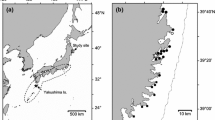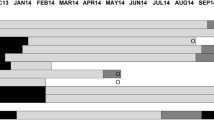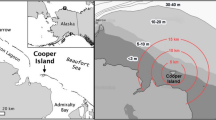Abstract
Penguins are highly specialized divers that are expected to reflect environmental variation by adjusting their foraging behavior. We performed a comprehensive analysis of the at-sea distribution, diving, and foraging performance of Magellanic penguins (Spheniscus magellanicus) during the early chick-rearing period over two consecutive breeding seasons. The study was conducted at Cabo dos Bahías, (44° 54′ 50″ S; 65° 32′ 37″ W) a breeding colony located south of the latitudinal range of penguins’ main prey item Argentine anchovies (Engraulis anchoita). We also linked penguin foraging behavior to sea surface temperature (SST) to examine how birds cope with differences in oceanographic conditions. For this, we instrumented 37 adult penguins (18 in 2015 and 19 in 2016) with data loggers. In addition, we recorded chick growth in body mass during the first 12 days of life. Overall, the diving patterns of adult Magellanic penguins were similar in both breeding seasons. However, during 2015, adult breeders spent more time at the sea surface between foraging dives and performed more foraging dives per hour. The time spent foraging was higher in 2016 than in 2015. Foraging penguins also expanded their foraging range more than 100 km during 2016. Temperature records gathered by diving penguins during 2016 showed significantly higher temperatures, both at the sea surface as well as at the bottom of dives. Adults performed a higher foraging effort and chicks gained weight faster during 2016. Site-specific variability in prey distribution and abundance may be responsible for inter-seasonal discrepancies in the foraging and diving patterns. We reasoned that any environmental change could cause a shift in the distribution of anchovies, which would change the foraging behavior of penguins as they attempted to optimize their chick growth. Penguins from Cabo dos Bahías appear to face this environmental challenge with a highly sensitive at-sea foraging performance by increasing foraging effort when necessary.




Similar content being viewed by others
Availability of data and material
The datasets generated and analyzed during this study are available from the corresponding author on request.
References
Andersson M (1978) Optimal foraging area: size and allocation of search effort. Theor Popul Biol 13:397–409
Barrionuevo M (2015) Inversión parental en el Pingüino de Magallanes (Spheniscus magellanicus): asincronía de eclosión, causas próximas y últimas
Barrionuevo M, Ciancio J, Marchisio N, Frere E (2018) Parental body condition and high energy value of fish determine nestling success in Magellanic penguin (Spheniscus magellanicus). Mar Biol 165:1–16
Bertellotti M, Tella JL, Godoy JA, Blanco G, Forero MG, Donázar JA, Ceballos O (2002) Determining sex of Magellanic Penguins using molecular procedures and discriminant functions. Waterbirds 25:479–484
Beyer HL (2004) Hawth's Analysis Tools for ArcGIS. Available at http://www.spatialecology.com/htools
BirdLife International (2000) Spheniscus magellanicus. The IUCN Red List of Threatened Species 2020. eT22697822A157428850 https://doi.org/10.2305/IUCNUK2020-3RLTST22697822A157428850en Downloaded on 19 May 2021
Birt V, Birt T, Goulet D, Cairns D, Montevecchi W (1987) Ashmole’s halo: direct evidence for prey depletion by a seabird. Mar Ecol Prog Ser 40:205–208
Boersma PD (2008) Penguins as marine sentinels. Bioscience 58:597–607
Boersma PD, Rebstock GA (2009) Foraging distance affects reproductive success in Magellanic penguins. Mar Ecol Prog Ser 375:263–275
Boersma PD, Rebstock GA (2014) Climate change increases reproductive failure in Magellanic penguins. PLoS ONE 9:e85602
Boersma PD, Frere E, Kane O, Pozzi LM, Pütz K, Raya Rey A, Rebstock GA, Simeone A, Smith J, Van Buren A, Yorio P, García-Borboroglu P (2013) Magellanic penguins (Spheniscus magellanicus). In: García-Borboroglu P, Boersma PD (eds) Penguins: natural history and conservation. University of Washington Press, Seattle, pp 232–263
Bonadonna F, Benhamou S, Jouventin P (2003) Orientation in “featureless” environments: the extreme case of pelagic birds. In: Berthold P, Gwinner E, Sonnenschein E (eds) Avian migration. Springer, Berlin Heidelberg, pp 367–377
Bost C-A, Handrich Y, Butler P, Fahlman A, Halsey L, Woakes A, Ropert-Coudert Y (2007) Changes in dive profiles as an indicator of feeding success in king and Adélie penguins. Deep Sea Res Part II 54:248–255
Bovet P, Benhamou S (1991) Optimal sinuosity in central place foraging movements. Anim Behav 42:57–62
Capurro A, Frere E, Gandini M, Gandini P, Holik T, Lichtschein V, Boersma PD (1988) Nest density and population size of Magellanic penguins (Spheniscus magellanicus) at Cabo Dos Bahias, Argentina. Auk 105:585–588
Carroll G, Everett JD, Harcourt R, Slip D, Jonsen I (2016) High sea surface temperatures driven by a strengthening current reduce foraging success by penguins. Sci Rep 6:1–13
Castillo J, Yorio P, Gatto A (2019) Shared dietary niche between sexes in Magellanic penguins. Austral Ecol
Ciancio JE, Yorio P, Wilson R, Frere E (2018) Food provisioning in Magellanic penguins as inferred from stable isotope ratios. Rapid Commun Mass Spectrom 32:489–494
Ciancio JE, Yorio P, Buratti C, Colombo GÁ, Frere E (2021) Isotopic niche plasticity in a marine top predator as indicator of a large marine ecosystem food web status. Ecol Indic 126:107687
Cotté C, Park Y, Guinet C, Bost C (2007) Movements of foraging king penguins through marine mesoscale eddies. Proc R Soc B 274:2385–2391
Crawley M (2007) The R book. Wiley, Chichester
Cresswell JE, Osborne JL, Goulson D (2000) An economic model of the limits to foraging range in central place foragers with numerical solutions for bumblebees. Ecol Entomol 25:249–255
Croxall JP, Trathan PN, Murphy EJ (2002) Environmental change and Antarctic seabird populations. Science 297:1510–1514. https://doi.org/10.1126/science.1071987
Cullen J, Chambers L, Coutin P, Dann P (2009) Predicting onset and success of breeding in little penguins Eudyptula minor from ocean temperatures. Mar Ecol Prog Ser 378:269–278
Dehnhard N, Eens M, Demongin L, Quillfeldt P, Poisbleau M (2015) Individual consistency and phenotypic plasticity in rockhopper penguins: female but not male body mass links environmental conditions to reproductive investment. PLoS ONE 10:e0128776
Del Caño M, Quintana F, Yoda K, Dell’Omo G, Blanco GS, Gómez-Laich A (2021) Fine-scale body and head movements allow to determine prey capture events in the Magellanic penguin (Spheniscus magellanicus). Mar Biol 168:1–15
Dornhaus A, Collins EJ, Dechaume-Moncharmont F-X, Houston AI, Franks NR, McNamara JM (2006) Paying for information: partial loads in central place foragers. Behav Ecol Sociobiol 61:151–161
Ehrlich MD, Martos P, Madirolas A, Sánchez RP (2000) Causes of spawning pattern variability of anchovy and hake on the Patagonian shelf ICES Council Meeting, pp 1–13
Elliott KH, Woo K, Gaston AJ, Benvenuti S, Dall’Antonia L, Davoren GK (2008) Seabird foraging behaviour indicates prey type. Mar Ecol Progress Ser 354:289–303
Fernandez SJ, Yorio P, Ciancio JE (2019) Diet composition of expanding breeding populations of the Magellanic penguin. Mar Biol Res 15:1–13
Frere E, Gandini P, Lichtschein V (1996) Variación latitudinal en la dieta del pingüino de magallanes (Spheniscus magellanicus) en la costa Patagónica, Argentina. Ornitologia Neotropical 7
Furness R, Birkhead T (1984) Seabird colony distributions suggest competition for food supplies during the breeding season. Nature 311:655–656
Garcia Borboroglu P, Pozzi L, Yorio P (2019) Breeding range expansion and population distribution shifts of Magellanic Penguins in northern Patagonia, Argentina. In: Otago Uo (ed) International Penguin Congress, Dunedin
Giudici PI, Quintana F, Svagelj WS (2017) The role of hatching asynchrony in a seabird species exhibiting obligate brood reduction. Waterbirds 40:221–232
Glembocki NG, Williams GN, Góngora ME, Gagliardini DA, Orensanz JML (2015) Synoptic oceanography of San Jorge Gulf (Argentina): a template for Patagonian red shrimp (Pleoticus muelleri) spatial dynamics. J Sea Res 95:22–35
Gómez-Laich A, Wilson RP, Sala JE, Luzenti A, Quintana F (2015) Moving northward: comparison of the foraging effort of Magellanic penguins from three colonies of northern Patagonia. Mar Biol 162:1451–1461. https://doi.org/10.1007/s00227-015-2681-1
Guinet C, Koudil M, Bost CA, Durbec JP, Georges JY, Mouchot MC, Jouventin P (1997) Foraging behaviour of satellite-tracked king penguins in relation to sea-surface temperatures obtained by satellite telemetry at Crozet Archipelago, a study during three austral summers. Mar Ecol Prog Ser 150:11–20
Hansen J, Martos P, Madirolas A (2001) Relationship between spatial distribution of the Patagonian stock of Argentine anchovy, Engraulis anchoita, and sea temperatures during late spring to early summer. Fish Oceanogr 10:193–206
Karnauskas K, Jenouvrier S, Brown C, Murtugudde R (2015) Strong sea surface cooling in the eastern equatorial Pacific and implications for Galápagos Penguin conservation. Geophys Res Lett 42:6432–6437
Krebs JR, Stephens DW, Sutherland WJ (1983) Perspectives in optimal foraging. Perspectives in ornithology. Cambridge University Press, Cambridge, pp 165–221
Labraga JC (1994) Extreme winds in the Pampa del Castillo Plateau, Patagonia, Argentina, with reference to wind farm settlement. J Appl Meteorol 33:85–95
Le Bohec C, Durant JM, Gauthier-Clerc M, Stenseth NC, Park Y-H, Pradel R, Gremillet D, Gendner J-P, Le Maho Y (2008) King penguin population threatened by Southern Ocean warming. Proc Natl Acad Sci 105:2493–2497
Lescroël A, Bost C-A (2005) Foraging under contrasting oceanographic conditions: the gentoo penguin at Kerguelen Archipelago. Mar Ecol Prog Ser 302:245–261
Pájaro M, Macchi GJ, Martos P (2005) Reproductive pattern of the Patagonian stock of Argentine hake (Merluccius hubbsi). Fish Res 72:97–108
Palma ED, Matano RP, Piola AR (2004) A numerical study of the Southwestern Atlantic Shelf circulation: Barotropic response to tidal and wind forcing. J Geophys Res Oceans 109
Parker GA, Smith JM (1990) Optimality theory in evolutionary biology. Nature 348:27–33
Peters G, Wilson RP, Scolaro JA, Laurenti S, Upton J, Galleli H (1998) The diving behavior of Magellanic penguins at Punta Norte, Península Valdés, Argentina. Colon Waterbirds 21:1–10
Pichegru L, Cook T, Handley J, Voogt N, Watermeyer J, Nupen L, McQuaid C (2013) Sex-specific foraging behaviour and a field sexing technique for Endangered African penguins. Endanger Species Res 19:255–264
Pinheiro JC, Bates DM (2000) Linear mixed-effects models: basic concepts and examples. Mixed-effects models in S and S-Plus, pp 3–56
Pisoni JP, Rivas AL, Piola AR (2015) On the variability of tidal fronts on a macrotidal continental shelf, Northern Patagonia, Argentina. Deep Sea Res Part II 119:61–68
Ponchon A, Grémillet D, Christensen-Dalsgaard S, Erikstad KE, Barrett RT, Reiertsen TK, McCoy KD, Tveraa T, Boulinier T (2014) When things go wrong: intra-season dynamics of breeding failure in a seabird. Ecosphere 5:art4. https://doi.org/10.1890/es13-00233.1
Pozzi LM, Borboroglu PG, Boersma PD, Pascual MA (2015) Population regulation in Magellanic penguins: what determines changes in colony size? PLoS ONE 10:e0119002. https://doi.org/10.1371/journal.pone.0119002
Quintana F, Wilson R, Prandoni N, Svagelj W, Gómez-Laich A (2021) Long-term ecology studies in Patagonian seabirds: a review with the Imperial Cormorant as a case study. In: Helbling EW, Narvarte MA, González RA, Villafañe VE (eds) Global change in Atlantic coastal Patagonian ecosystems: a journey through time. Springer (in press)
R Development Core Team (2019) A language and environment for statistical computing. Vienna, Austria: R Foundation for Statistical Computing. Available from: https://www.r-project.org
Raya Rey A, Bost C-A, Schiavini A, Pütz K (2010) Foraging movements of Magellanic penguins Spheniscus magellanicus in the Beagle Channel, Argentina, related to tide and tidal currents. J Ornithol 151:933–943
Raya Rey A, Pütz K, Scioscia G, Lüthi B, Schiavini A (2012) Sexual differences in the foraging behaviour of Magellanic penguins related to stage of breeding. Emu-Austral Ornithol 112:90–96
Raya Rey A, Rosciano N, Liljesthröm M, Samaniego RS, Schiavini A (2014) Species-specific population trends detected for penguins, gulls and cormorants over 20 years in sub-Antarctic Fuegian Archipelago. Polar Biol 37:1343–1360
Romero SI, Piola AR, Charo M, Garcia CAE (2006) Chlorophyll-a variability off Patagonia based on SeaWiFS data. J Geophys Res Oceans 111:C05021. https://doi.org/10.1029/2005jc003244
Ropert-Coudert Y, Chiaradia A, Ainley D, Barbosa A, Boersma PD, Brasso R, Dewar M, Ellenberg U, García-Borboroglu P, Emmerson L, Hickcox R, Jenouvrier S, Kato A, McIntosh RR, Lewis P, Ramírez F, Ruoppolo V, Ryan PG, Seddon PJ, Sherley RB, Vanstreels RET, Waller LJ, Woehler EJ, Trathan PN (2019) Happy feet in a hostile world? The future of penguins depends on proactive management of current and expected threats. Front Mar Sci. https://doi.org/10.3389/fmars.2019.00248
Rosciano NG, Pütz K, Polito MJ, Raya Rey A (2018) Foraging behaviour of Magellanic penguins during the early chick-rearing period at Isla de los Estados, Argentina. Ibis 160:327–341
Roy C, Van der Lingen C, Coetzee J, Lutjeharms J (2007) Abrupt environmental shift associated with changes in the distribution of Cape anchovy Engraulis encrasicolus spawners in the southern Benguela. Afr J Mar Sci 29:309–319
Sala JE, Wilson RP, Frere E, Quintana F (2012a) Foraging effort in Magellanic penguins in coastal Patagonia, Argentina. Mar Ecol Prog Ser 464:273–287. https://doi.org/10.3354/meps09887
Sala JE, Wilson RP, Quintana F (2012b) How much is too much? Assessment of prey consumption by Magellanic penguins in Patagonian Colonies. PLoS ONE 7:e51487. https://doi.org/10.1371/journal.pone.0051487
Sala JE, Wilson RP, Frere E, Quintana F (2014) Flexible foraging for finding fish: variable diving patterns in Magellanic penguins Spheniscus magellanicus from different colonies. J Ornithol 155:801–817
Sala JE, Pisoni JP, Quintana F (2017) Three-dimensional temperature fields of the North Patagonian Sea recorded by Magellanic penguins as biological sampling platforms. Estuar Coast Shelf Sci 189:203–215
Schiavini A, Yorio P, Gandini P, Raya Rey A, Dee Boersma P (2005) Los pingüinos de las costas argentinas: estado poblacional y conservación. El Hornero 20:5–23
Scioscia G, Rey AR, Schiavini A (2016) Breeding biology of Magellanic penguins (Spheniscus magellanicus) at the Beagle Channel: interannual variation and its relationship with foraging behaviour. J Ornithol 157:773–785
Silva C, Andrade I, Yáñez E, Hormazabal S, Barbieri MÁ, Aranis A, Böhm G (2016) Predicting habitat suitability and geographic distribution of anchovy (Engraulis ringens) due to climate change in the coastal areas off Chile. Prog Oceanogr 146:159–174
Simeone A, Wilson RP (2003) In-depth studies of Magellanic penguin (Spheniscus magellanicus) foraging: can we estimate prey consumption by perturbations in the dive profile? Mar Biol 143:825–831
Sutton G, Pichegru L, Botha JA, Kouzani AZ, Adams S, Bost CA, Arnould JP (2020) Multi-predator assemblages, dive type, bathymetry and sex influence foraging success and efficiency in African penguins. PeerJ 8:e9380
Tremblay Y, Cherel Y (2000) Benthic and pelagic dives: a new foraging behaviour in rockhopper penguins. Mar Ecol Prog Ser 204:257–267
Weimerskirch H, Bonadonna F, Bailleul F, Mabille G, Dell’Omo G, Lipp H-P (2002) GPS tracking of foraging albatrosses. Science 295:1259–1259
Wilson RP, Puetz K, Peters G, Culik B, Scolaro JA, Charrassin JB, Ropert-Coudert Y (1997) Long-term attachment of transmitting and recording devices to penguins and other seabirds. Wildl Soc Bull 25:101–106
Wilson RP, Ropert-Coudert Y, Kato A (2002) Rush and grab strategies in foraging marine endotherms: the case for haste in penguins. Anim Behav 63:85–95
Wilson RP, Scolaro JA, Grémillet D, Kierspel MA, Laurenti S, Upton J, Gallelli H, Quintana F, Frere E, Müller G (2005a) How do Magellanic penguins cope with variability in their access to prey? Ecol Monogr 75:379–401
Wilson RP, Scolaro JA, Grémillet D, Kierspel MAM, Laurenti S, Upton J, Gallelli H, Quintana F, Frere E, Muller G, Straten MT, Zimmer I (2005b) How do Magellanic penguins cope with variability in their access to prey? Ecol Monogr 75:379–401
Wilson RP, Jackson S, Straten MT (2007) Rates of food consumption in free-living Magellanic penguins Spheniscus magellanicus. Mar Ornithol 35:109–111
Wilson RP, McMahon CR, Quintana F, Frere E, Scolaro A, Hays GC, Bradshaw CJ (2011) N-dimensional animal energetic niches clarify behavioural options in a variable marine environment. J Exp Biol 214:646–656
Wilson R, Sala J, Gómez-Laich A, Ciancio J, Quintana F (2015) Pushed to the limit: food abundance determines tag-induced harm in penguins. Anim Welf 24:37–44
Worton BJ (1989) Kernel methods for estimating the utilization distribution in home-range studies. Ecology 70:164–168
Yorio P, Frere E, Gandini P, Harris G (1998) Atlas de la distribución reproductiva de aves marinas en el litoral Patagónico Argentino. Fundación Patagonia Natural Puerto Madryn
Yorio P, González-Zevallos D, Gatto A, Biagioni O, Castillo J (2017) Relevance of forage fish in the diet of Magellanic penguins breeding in northern Patagonia, Argentina. Mar Biol Res 13:603–617. https://doi.org/10.1080/17451000.2016.1273529
Zar JH (1999) Biostatistical analysis. Pearson Education India
Zuur A, Ieno EN, Walker N, Saveliev AA, Smith GM (2009) Mixed effects models and extensions in ecology with R. Springer Science & Business Media
Acknowledgements
We thank Dr. T. A. Clay and two anonymous reviewers for their suggestions that improved the manuscript. We would like to express our gratitude to Dr. R. Wilson for his helpful comments on the manuscript. Special thanks to R. Sardi, M. Descalzo, N. Prandoni, and Earthwatch volunteers for their help in the field and Dr. A. Gomez-Laich for help with analysis in R. Earthwatch Institute funded this project. We thank Instituto de Biología de Organismos Marinos (IBIOMAR), CCT CONICET-CENPAT for institutional support. We are grateful to personnel of Parque Interjurisdiccional Marino Costero Patagonia Austral for their support.
Funding
This study was funded by Earthwatch Institute. Grant awarded to F.Q. and G.S.B.
Author information
Authors and Affiliations
Contributions
GSB and FQ conceived the study. GSB, GM, GD-O, and FQ collected data. JPP analyzed oceanographic data. GSB analyzed spatial data. NAG analyze dive data. LG completed statistical analysis. GSB and FQ wrote the initial manuscript. GD-O provided resources. All authors contributed to the reviewing and editing.
Corresponding author
Ethics declarations
Conflict of interest
All authors declare that they have no conflict of interest.
Compliance with ethical standards
Research permits (No. 075-SsCyAP/15 and 133-SsCyAP/16) were granted by Subsecretaría de Turismo y Areas Protegidas and Dirección de Fauna y Flora Silvestre, dependent from the Ministry of Tourism and Protected Areas of Chubut Province, Argentina. Handling of penguins during instrumentation was performed as efficiently as possible.
Informed consent
We confirm that the manuscript has been read and approved by all named authors.
Additional information
Responsible Editor: T.A. Clay.
Publisher's Note
Springer Nature remains neutral with regard to jurisdictional claims in published maps and institutional affiliations.
Rights and permissions
About this article
Cite this article
Blanco, G.S., Gallo, L., Pisoni, J.P. et al. At-sea distribution, movements and diving behavior of Magellanic penguins reflect small-scale changes in oceanographic conditions around the colony. Mar Biol 169, 29 (2022). https://doi.org/10.1007/s00227-021-04016-5
Received:
Accepted:
Published:
DOI: https://doi.org/10.1007/s00227-021-04016-5




